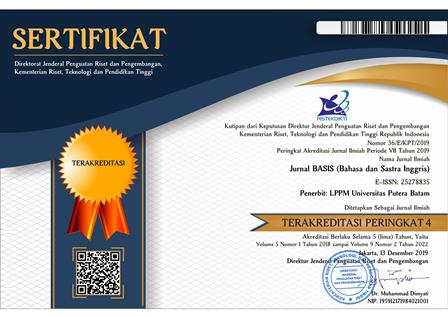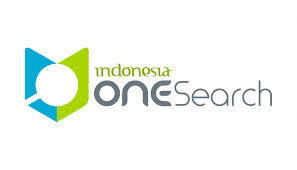EVALUATIVE LANGUAGE FEATURES ON HOAX RELATED TO METH DRUGS IN DEALING WITH COVID 19 VIRUS
DOI:
https://doi.org/10.33884/basisupb.v9i2.5607Keywords:
Attitude, Appraisal, hoax news, Covid-19 PandemicAbstract
Hoax news related to Covid 19 pandemic was spread in the US. In some cases, it is rather difficult to differentiate between real and fake news. Therefore, this study has an aim to analyse the evaluative features of online news using appraisal theory on the attitude subsystem. The appraising items focused on attitude division in the Huzlers about Corona Virus published in 2020 as the fake news and NBC news in 2012 as the real news regarding to the use of Meth to deal with Flu virus. Both news are American Media and were published online. This main purpose of this research is to explain the realization of fake and real news with the similar topics. The data used in this study was taken from Huzlers and NBC news and was collected in three steps: comparing, intensive reading, and transcribing. Moreover, the data were analysed into three steps: classifying, categorizing and analysing using Attitude theory which is one of appraisal theory aspects in SFL discourse semantics (Martin, J. R., & Rose 2007, Martin & White 2005, Martin 2019). The results of this study found that both news, real and fake news are dominated by appreciation. However, in fake news there is a tendency that the positive polarity is used to favour meth drugs, meanwhile in real news, it shows the polarity in balance. In addition, in fake news, there is also a tendency to use judgment to appraise the people involved in the meth drugs research.
References
Adendorff, R & Smith, J 2014, ‘The creation of an “imagined community” in readers’ letters to the Daily Sun: An APPRAISAL investigation’, Text and Talk, vol. 34, no. 5, pp. 521–544.
Bangga, LA & Lukmana, I 2019, ‘Recontextualising NAPLAN: A functional analysis of evaluations in media texts’, Indonesian Journal of Applied Linguistics, vol. 9, no. 1, pp. 128–137.
Bingjie Deng & Michael Chau (2021) The Effect of the Expressed Anger and Sadness on Online News Believability, Journal of Management Information Systems, 38:4, 959-988, DOI: 10.1080/07421222.2021.1990607
Budak, C 2019, ‘What happened? The spread of fake news publisher content during the 2016 U.S. Presidential election’, The Web Conference 2019 - Proceedings of the World Wide Web Conference, WWW 2019, , no. 2, pp. 139–150.
Cahyadi, H 2017, Pendekatan teori linguistik sistemik fungsional, Universitas Sumatera Utara.
Coffin, C & O’Halloran, K 2006, ‘The role of appraisal and corpora in detecting covert evaluation’, Functions of Language, vol. 13, no. 1, pp. 77–110.
Halliday, MAK & Matthiessen, CMIM 2014, Halliday’s introduction to functional grammar, 4th edn.
Hinson, K 2020, ‘E Ffective in T Reating’, , pp. 2–5.
Juditha, C 2018, ‘Hoax Communication Interactivity in Social Media and Anticipation (Interaksi Komunikasi Hoax di Media Sosial serta Antisipasinya)’, Journal Pekommas, vol. 3, no. 1, p. 31.
Luengo, M & García-Marín, D 2020, ‘The performance of truth: politicians, fact-checking journalism, and the struggle to tackle COVID-19 misinformation’, American Journal of Cultural Sociology, vol. 8, no. 3, pp. 405–427, <https://doi.org/10.1057/s41290-020-00115-w>.
MacDougall, C 1958, Hoaxes, Dover Publications, Newyork.
Martin, J. R., & Rose, D 2007, Working with discourse 2nd edition.
Martin, JR 2019,‘Discourse Semantics’, in S Thompson, Bowcher, Fontaine (ed.), The cambridge handbook of Systemic Functional Linguistics, pp.358–381.
Martin, JR & White, PRR 2005, The Language of Evaluation: Appraisal in English.
Musyaffa 2017, Mengenali hoax dari sudut pandang kebahasaan juga berpotensi untuk meningkatkan kesadaran dan pemahaman masyarakat terkait bagaimana secara tipikal berita-berita hoax dikonstruksi, mempertajam pemahaman dan penerapan literasi media di kalangan masyarakat, UIN SYARIFHIDAYATULLAHJAKARTA,<http://repository.uinjkt.ac.id/dspace/bitstream/123456789/38300/1/MUSYAFFA-FDK.pdf>.
Posetti, J et al. 2018, UNESCO: Journalism, ‘Fake News’ & Disinformation, <http://unesdoc.unesco.org/images/0026/002655/265552E.pdf>.
Qalby, N, Alaydrus, SS, & Darmayanti, A 2019, ‘Pengaruh Media Sosial Terhadap Penyebaran Hoax Oleh Digital Pengaruh Media Sosial Terhadap Penyebaran Hoax’, , , no. January.
Rafida, T 2014, ‘Metafungsi dan Konteks Sosial dalam teks Imlek Peserta Didik Etnik Tionghoa Medan’.
Ross, AS & Caldwell, D 2020, ‘“Going negative”: An APPRAISAL analysis of the rhetoric of Donald Trump on Twitter’, Language and Communication, vol. 70, no. xxxx, pp. 13–27, <https://doi.org/10.1016/j.langcom.2019.09.003>.
Suryaman, M, Kusmarwanti, & Budiyanto, D (eds.) 2015,‘Prosiding Seminar Nasional Bahasa, Sastra, dan Kekuasaan’, in, Jurusan Bahasa dan Sastra Indonesia Fakultas Bahasa dan Seni Universitas Negeri Yogyakarta,Yogyakarta,p.474,<http://fbs.uny.ac.id/sites/fbs.uny.ac.id/files/Prosiding Seminar_Bahasa dan Kekuasaan.pdf.pdf>.
Tavassoli, F, Jalilifar, A, & White, PRR 2019, ‘British newspapers’ stance towards the Syrian refugee crisis: An appraisal model study’, Discourse and Society, vol. 30, no. 1, pp. 64–84.
Utami, P 2019, ‘Hoax in Modern Politics’, Jurnal Ilmu Sosial dan Ilmu Politik, vol. 22, no. 2, p. 85.
Verma, S & Gustafsson, A 2020, ‘Investigating the emerging COVID-19 research trends in the field of business and management: A bibliometric analysis approach’, Journal of Business Research, vol. 118, no. June, pp. 253–261, <https://doi.org/10.1016/j.jbusres.2020.06.057>.
Young, L 2011,‘Systemic functional linguistics’, in, The Routledge Handbook of Applied Linguistics.
Zaluchu, SE 2020, ‘Dinamika Hoax, Post-Truth dan Response Reader Criticism di Dalam Rekonstruksi Kehidupan Beragama’, Religió: Jurnal Studi Agama-agama, vol. 10, no. 1, pp. 98–117.
Zhou, F 2020, ‘“How can Johns Hopkins not be angry?” A discursive case study of Chinese lay expert’s science communication in the digital age’, Language and Communication, vol. 74, pp. 41–51.

















